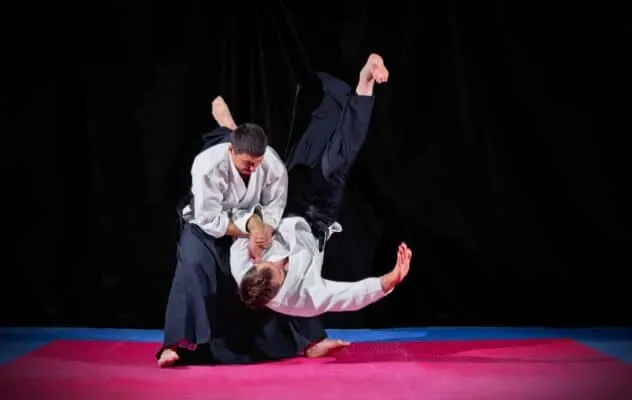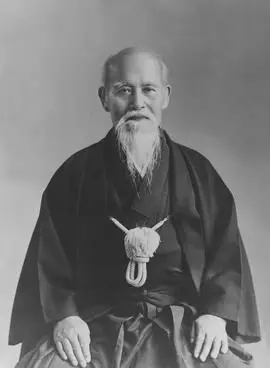
Aikido is a relatively new martial art compared to some of the other ancient arts still practiced today. Many people have not heard much about Aikido, and some of the coverage of this art in the media has not been favorable. Let’s delve into what Aikido is all about, and you can decide whether it is a martial art you should consider practicing.
Aikido is a Japanese martial art style created by Morihei Ueshiba in the mid-1920s. It is derived from Daito-Ryu Jujutsu, but the focus is on self-defense with doing minimal harm to the attacker. Aikido does not require strength but focuses on throws, redirection, joint locks, and weapons.
Aikido is a martial art steeped in principle and belief, born out of a philosophy of self-defense where both parties can walk away to live another day. This Japanese martial art has grown in popularity to the point that it is practiced worldwide today. Why do some people question its effectiveness, and is there any foundation to their claims?.
History Of Aikido
The martial art of Aikido is considered to be a modern combat art since it was developed in the 1900s and does not have the same history as many other martial arts.
Even though Aikido is a relatively new martial art, it does not mean that it does not have roots in other older martial arts styles.
The founder of Aikido, Morihei Ueshiba, participated in the Russo-Japanese War in the early 1900s, which affected him deeply. After the war, he trained in the art of Daito-Ryu-jujutsu under Takeda Sokaku in Japan. Morihei Ueshiba sought spiritual enlightenment through the Shinto sect, Omoto-Kyo. Morihei Ueshiba developed Aikido in the mid-1920s, where he sought to combine his spiritual philosophy with his martial art.

Image Credit: Wikipedia
After World War II, Morihei Ueshiba retired to Iwama, a small village in Japan, where he continued to teach Aikido. In the early days, the style was known as Aiki-Jujutsu, but later became known as Aikido, which means “the way of harmony with life-energy” or “the way of spiritual harmony.”
After the death of Morihei Ueshiba in 1969 at the age of 85, his students continued teaching the style, but some deviated from the teachings of the founder, or Osensei.
One of Ueshiba’s most dedicated students, Morihiro Saito, known in the Aikido world as Saito Sensei, made it his lifelong commitment to teaching Aikido in the way of the founder.
The styles that were derived from Aikido became known by several names, including the following.
- Iwama Ryu
- Iwama ShinShin Aiki Shuren Kai
- Shodokan Aikido
- Yoshinkan
- Aikikai
- Renshinkai
- Ki Aikido
- Takemusu Aikido
What Is The Purpose Of Aikido?
The purpose of Aikido is a noble one, where you learn to defend yourself without destroying your attacker. One of the founder’s favorite statements was “true and final victory over oneself, here and now,” indicating the discipline needed to overcome one’s own emotions and anger and control your response to aggression.
Morihei Ueshiba often referred to Aikido as “the way of love,” to create the foundation of caring for your attacker rather than responding in anger and vengeance and severely injuring or killing your opponent.
Aikido includes the principles of entering to not give your opponent space to conclude their attack, strikes to the body, turning movements to avoid attacks and redirecting your opponent’s energy, throws, joint locks, and weapons training.
What Are The Rules Of Aikido?
Aikido is a very traditional martial art, with much emphasis placed on respect and Japanese traditions in the art.
There are strict protocols to training in the dojo, respect for your sensei, proper execution of the techniques, and focus on training mind and body.
Aikido students are not encouraged to participate in competitions, and the martial art does not have tournaments where students compete against each other. Various Aikido dojos may come together on occasion to train with each other and learn and participate in demonstrations.
Aikido students wear a gi, similar to Judo, and start with a white belt. While there are grades in Aikido, they are not denoted by belt color. An Aikido student remains a white belt until they attain a black belt. While strikes are practiced in training, no full contact for strikes is allowed.
Is Aikido Hard To Learn?
Aikido is a fairly difficult martial art to learn because it has many traditions that must be observed, and the techniques must be executed accurately to be effective and prevent serious injury.
It is possible with extreme dedication and training 2 to 3 times per week to attain a black belt in Aikido in 4 or 5 years, but it is more common for this achievement to take between 7 and 10 years for most students.
This is not to say that you will not learn much in your Aikido journey, but rather that it takes an extra measure of commitment to your training to master the techniques in this martial art.
Is Aikido Effective In A Street Fight?
Aikido is effective in a street fight since many of the techniques taught in Aikido are for dealing with multiple attackers.
The techniques taught in Aikido can cause debilitating injury and can cause death, but the Aikido student is taught to execute the techniques with restraint.
Aikido students are taught various disarming techniques that can be used to disarm an attacker wielding a knife, a stick, or a sword.
RECOMMENDED FOR YOU: Is Jeet Kune Do Effective? Here’s a Closer Look
Is Aikido Dangerous?
The techniques taught in Aikido are highly dangerous and can break bones, dislocate joints, knock people unconscious or even cause death. This is one of the primary reasons that Aikido students take longer to master the techniques compared to other martial arts. Great emphasis is placed on executing the techniques correctly to prevent serious injury.
Even though the moves taught in Aikido are dangerous and potentially deadly, it is part of this martial art’s philosophy to restrain yourself and only use enough force to stop the attack rather than annihilate your enemy.
Does Aikido Use Weapons?
Aikido teaches the use of weapons and includes defensive moves against an armed assailant, as well as how to use weapons to defend yourself.
The training with a knife, or tanto, is mostly aimed at teaching defense against a knife attack and removing the weapon from the attacker’s grasp.
Aikido also teaches techniques using the sword and the staff, or jo, a wooden stick measuring about 4.2-feet or 1.27-meters long.
Is There Any Sword Fighting In Aikido?
Aikido includes an extensive training program using the sword to defend and attack. Sword training is implemented using a wooden replica of a katana, called a bokken.
Many of the empty-hand techniques taught as part of unarmed combat training can be related back to the sword techniques. This makes mastering the sword an important part of the empty-hand training curriculum.
Is Aikido Popular In Japan?
Aikido is a popular martial art in Japan, with an estimated 1 million aikido practitioners in the country.
Aikido techniques are taught to the Japanese police force and the military. The police use it as an effective means to subdue people without causing injury, whereas the military learns the style for unarmed combat techniques, which can be used to apply deadly force.
RECOMMENDED FOR YOU: Top 6 Martial Arts for Police Officers – Why They’re Great
Why Do People Say Aikido Is Not Effective In Real Life?
Aikido is viewed in many circles as ineffective because of the style’s philosophy of “do no harm” taught to the students.
Aikido is considered a “soft” martial art, so Aikido practitioners will not exert enough force to stop an attack in real life because they have been taught to restrain themselves.
In reality, Aikido is effective, but it requires many years of training to execute the moves correctly for the techniques to have the desired effect. In our modern, “instant” society, many people do not have the discipline or the patience to put in the training to become proficient.
RECOMMENDED FOR YOU: Do Most Traditional Martial Arts Actually Work?
What is the key difference between Aikido and other martial arts?
Many other martial arts rely on power and strength to overcome an opponent. Aikido differs from other martial arts styles in that it focuses on redirecting your opponent’s energy to work against them rather than using your strength against them.
This foundational principle of Aikido means that it can be learned by people of any age, physical ability, or strength. It is an ideal martial art for women to learn, who would not be able to match the strength of a male attacker.
Balance, positioning, timing, and correct execution of the techniques are key to redirecting the assailant’s momentum and strength to your advantage.
The techniques in Aikido intend to quench the attack without doing extensive damage to the attacker, giving the person being attacked the chance to get away from the danger. One of the key principles in Aikido is to avoid a confrontation if possible, but if the confrontation is inevitable, you have effective skills to stop the attack.
Key Difference Between Aikido Vs. Hapkido
Aikido is a Japanese martial art, whereas Hapkido is a Korean martial art. Hapkido does not have the same spiritual philosophy as Aikido and is, therefore, more aggressive in its teachings.
Hapkido places more emphasis on punches and kicks and includes the use of sticks as a weapon for attack. Aikido focuses on defense and does not include any kicks as part of the curriculum.
Still curious? Click here to learn more about Hapkido vs Aikido – Key Differences Explained For Beginners
Is Aikido Effective In MMA?
Some techniques in Aikido are useful to an MMA fighter, especially teaching balance and avoiding strikes from the opponent.
However, the aim of MMA to cause bodily harm to the opponent is completely opposite to the philosophy of Aikido.
As a result, not many of the techniques in Aikido will be effective in MMA since they each have different end goals.
Conclusion
Aikido is a controversial martial art, but it is still popular as an effective self-defense style that is still practiced worldwide in over 140 countries.
Aikido is particularly effective for people of smaller stature or strength, especially women, since the techniques taught are designed to use the opponent’s strength and momentum against them.
The techniques used in Aikido are effective and dangerous but require patience and dedication to master.
